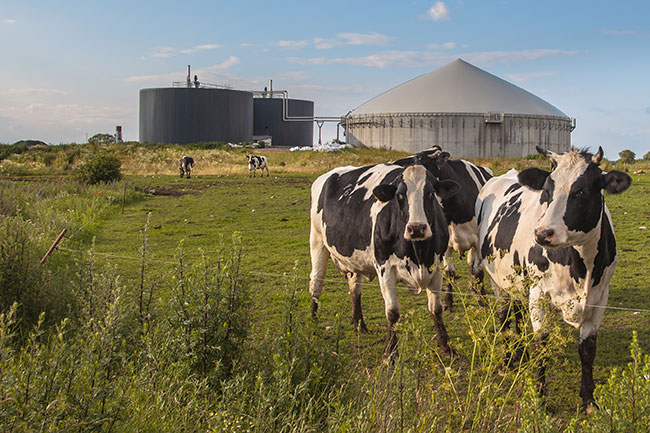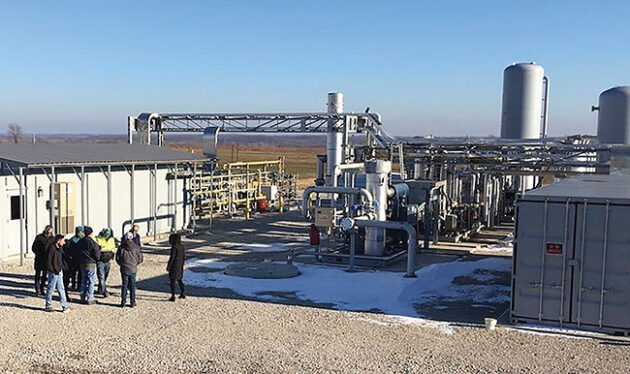
Features
Anaerobic Digestion
Biofuels
Energy
The latest research on renewables
Manure as a form of renewable energy is moving beyond niches.
April 10, 2023 by Richard Kamchen
 Anaerobic digesters are more common in ag, but there are enhancements yet to come.
photo creativenature.nl/adobe stock
Anaerobic digesters are more common in ag, but there are enhancements yet to come.
photo creativenature.nl/adobe stock A regular reader of Manure Manager knows better than to consider manure a waste. Manure has proven itself time and time again as anything but by regenerating soils and improving crop yields.
More so, researchers are endeavouring to prove its growing value as a source of sustainable energy.
“There’s always been a lot of interest in sustainable fuels, but more recently, given carbon programs and a greater focus on reducing agriculture’s and humanity’s impacts on carbon and the environment, I think opportunities have really taken off,” says Daniel Andersen, who specializes in manure management at Iowa State University (ISU).
As anaerobic digestion and alternatively fueled vehicles expand from niche novelties to widely adopted innovations, here’s a status report on advances in manure as alternative fuels.
Background: Anaerobic digestion
How manure fits in as a source of renewable fuel is through anaerobic digestion.
During this natural process, microorganisms break down biomatter and produce biogas – a combination of methane and carbon dioxide.
Anaerobic digesters – such as municipal digesters or on-farm digesters – tend to nab a lot of the spotlight. But Andersen says anaerobic digestion occurs in all situations, to some degree. “No matter how we’re storing our manures, some amount of anaerobic digestion will occur,” explains Andersen.But unless captured, both methane and CO2 go into the atmosphere. Methane’s especially problematic, as the potent greenhouse gas has about 28 times the global warming potential of CO2 over the course of 100 years, Andersen says.
Given that, researchers are looking for more sustainable practices by enhancing anaerobic digestion, and capturing the methane that manure produces. In this way, methane, the main component of natural gas, not only is prevented from escaping to the atmosphere, but it isn’t wasted either.
“Improved manure management, improved sustainability of livestock, can make a difference,” says Andersen. “If we can reduce our footprint for producing milk, meat and eggs, while making renewable energy, I think that’s an opportunity that’s pretty exciting.”
New research
In 2020, ISU, Penn State and Roeslein Alternative Energy received a five-year, $10 million federal grant to develop new methods of turning manure and biomass into fuel.
An ISU press release at the time explained that new separation technologies would allow biogas to be upgraded to renewable natural gas, which could then be distributed through a gas pipeline network, similar to how renewable electricity is distributed through an electrical grid.
“We will enhance that methane production by providing the right environment to maximize the microbe growth,” says Andersen. “Those microbes are really what are breaking down that carbon that’s in the manure, and just increasing the amount of methane that it’s making, capturing that and either combusting it for electricity, or in many cases, cleaning it, taking it to relatively pure methane instead of biogas.”
He notes equipment to clean biogas for electricity is oftentimes less expensive. Although the carbon credits might be less lucrative too, it’s balanced out by the lower capital cost of getting a project going.

A $10 million, five-year grant awarded to Iowa State University in 2020 will power the Consortium for Cultivating Human and Natural regenerative Enterprise (C-CHANGE).
Image courtesy of Iowa State University
Powering electric vehicles
Much of the research done on anaerobic digestion goes back to the 1960s and ’70s and the first energy crisis, and then again in the early 2000s, Andersen explains. “As we think about reducing humanity’s carbon footprint on the world, transportation and energy clearly are the drivers.”
Anderson has watched a rapid expansion in the amount of anaerobic digestion facilities throughout the Midwest. In the last year in Iowa alone, there’s been more than a tripling in the number of anaerobic digesters, from four to 13.
“And we’ve seen massive expansion of this technology in states like North Carolina, Oklahoma and Texas,” he adds. “We’re already on the front edge of a lot of implementations, because the carbon credit market is quite lucrative at the moment, from programs like the EPA’s D3 RIN market, as well as low carbon fuel standards that various states out west like California, Washington, Oregon – and even Canada – have implemented in recent years.”
Governmental emphasis on putting more electric-powered vehicles on the road and new EPA proposals look to be a boon.
The EPA last December proposed a rule to establish required Renewable Fuel Standard (RFS) volumes and percentage standards for 2023, 2024 and 2025. The EPA explained its proposed rule included regulatory changes to prescribe how RINs from renewable electricity (eRINs) would be implemented and managed under the RFS program. This would allow parties to register with the EPA and generate eRINs produced from qualifying renewable biomass used as transportation fuel.
“The EPA’s finalizing the rules of how eRIN would work right now, and that would really open up powering electric cars with electricity made from manure,” says Andersen.
Biomass
He adds, however, that Iowa would have a tough time relying on manure alone to feed its digesters.
“One of the challenges we see here in Iowa is that oftentimes these projects need relatively large farms, probably at least 1,000 dairy cattle, 15 to 20,000 pigs. And while Iowa has lots of animals, our farms tend to not be that big. To help our farms be more competitive in this space, we’re really interested in other biomass materials that we can use to supplement that gas production to reach the scale we need.”
ISU received another grant, this time in 2022, of about $10 million to demonstrate how generating renewable natural gas from cover crops and prairie grass could finically motivate farmers to implement conservation practices that would sequester carbon dioxide and improve water quality.
He says the Midwestern landscape, once mostly prairie, is dominated by corn and soybeans, and that this project aims to find a way to incentivize a return to prairie or crops other than corn and soybeans.
Through both the 2020 and 2022 grant-funded projects, researchers hope to achieve a several goals. “One is to demonstrate a model of what a system could look like to really get water quality, wildlife habitats, and energy production benefits at a reasonable farm scale, where people could see how it would work, and what it might look like on their farm,” says Andersen.
Another is to help manure management become more sustainable, and “to turn rural areas, especially rural Iowa and the Midwest, into an area [with] economic opportunity from the energy production.” •